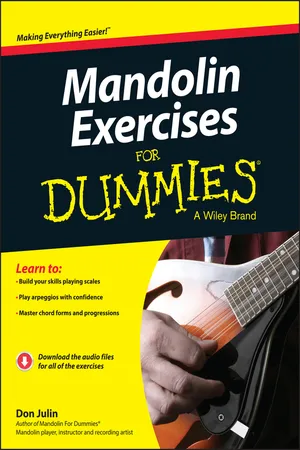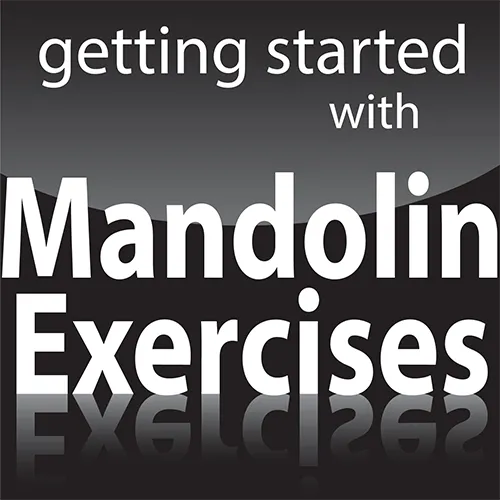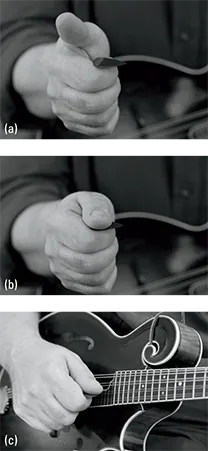
- English
- ePUB (mobile friendly)
- Available on iOS & Android
eBook - ePub
Mandolin Exercises For Dummies
About this book
Dummies focuses on the skills that players often find challenging and provides tips, tricks and plenty of cool exercises that will have you picking with the best of them—or at least much better than before! Mandolin Exercises For Dummies is packed with instruction—from hundreds of exercises to drills and practice pieces. And it gets better. You'll also have online access to downloadable audio files for each exercise, making this practice-based package a complete mandolin companion.
- Puts an overview of the fundamentals in perspective, helps you to use exercises to limber up, and much more
- Dives into the major and minor arpeggios with triad patterns, then moves on to major 7th and minor 7th patterns
- Details the major scales, then moves on to mastering the minor scales with practice exercises
- Contains tips to help you practice better, including using a metronome, playing with recordings, and more
Master the basics and sharpen your mandolin-playing skills with this reliable resource.
Frequently asked questions
Yes, you can cancel anytime from the Subscription tab in your account settings on the Perlego website. Your subscription will stay active until the end of your current billing period. Learn how to cancel your subscription.
No, books cannot be downloaded as external files, such as PDFs, for use outside of Perlego. However, you can download books within the Perlego app for offline reading on mobile or tablet. Learn more here.
Perlego offers two plans: Essential and Complete
- Essential is ideal for learners and professionals who enjoy exploring a wide range of subjects. Access the Essential Library with 800,000+ trusted titles and best-sellers across business, personal growth, and the humanities. Includes unlimited reading time and Standard Read Aloud voice.
- Complete: Perfect for advanced learners and researchers needing full, unrestricted access. Unlock 1.4M+ books across hundreds of subjects, including academic and specialized titles. The Complete Plan also includes advanced features like Premium Read Aloud and Research Assistant.
We are an online textbook subscription service, where you can get access to an entire online library for less than the price of a single book per month. With over 1 million books across 1000+ topics, we’ve got you covered! Learn more here.
Look out for the read-aloud symbol on your next book to see if you can listen to it. The read-aloud tool reads text aloud for you, highlighting the text as it is being read. You can pause it, speed it up and slow it down. Learn more here.
Yes! You can use the Perlego app on both iOS or Android devices to read anytime, anywhere — even offline. Perfect for commutes or when you’re on the go.
Please note we cannot support devices running on iOS 13 and Android 7 or earlier. Learn more about using the app.
Please note we cannot support devices running on iOS 13 and Android 7 or earlier. Learn more about using the app.
Yes, you can access Mandolin Exercises For Dummies by Don Julin in PDF and/or ePUB format, as well as other popular books in Media & Performing Arts & Guitar Music. We have over one million books available in our catalogue for you to explore.
Information
Part I
Getting Ready to Practice

In this part …
- Mentally prepare yourself to play the mandolin.
- Warm yourself up with stretching, coordination and strength building exercises.
- Refresh your memory of left and right hand mandolin basics.
- Review your knowledge of reading tablature, chord and neck diagrams.
Chapter 1
Getting the Basics Sorted: Mandolin Fundamentals
In This Chapter



You can’t play the mandolin without using your hands and fingers. So in this chapter I run through the left- and right-hand basics (check out Mandolin For Dummies for more details). I take the opportunity to cover the following: holding the pick, basic picking techniques, left-hand fingerings, and proper left-hand grip. I also include reading tablature, chord diagrams, and neck diagrams.
If you already know some of this material, taking a second look never hurts. Reminding yourself is usually good, unless of course it’s a reminder about how awful it feels to trip over and put your foot through your favorite mandolin!
Tuning Up
Covering a Few Right-Hand Basics
One of the most important elements in mandolin playing is having a strong, co-ordinated, and organized right hand. This hand is responsible for rhythm, tone, dynamics, and speed. It needs to stay relaxed and loose while you’re playing. Small adjustments in the way you hold the pick can dramatically change your tone or even your ability to play at faster tempos. (I give you tips on speeding up in Chapter 16.)
Another often-overlooked part of mandolin playing is maintaining proper pick direction. Many of the exercises in this book include elements that deal with pick direction to help strengthen and develop your left and right hands.
Holding the pick
Beginners often pass over this basic skill, but sooner or later you need to come to grips with the way you hold your pick:
- Make your right hand a loose fist with your thumb sticking up a bit.
- Lay the pick on the side of your first finger, as shown in Figure 1-1 (a).
- Place your thumb over the pick so that you’re holding the pick between the pad of your thumb and the side of your index finger (b).
- Hold the pick as loosely as you can. A death grip may be great for subduing aggressive Klingons, but it’s no good for playing the mandolin. Too tight a grip on your pick guarantees bad tone and uneven tremolo, and may even get you thinking that you’ll never be able to play quickly.

- Position your right hand so that the pick hits the strings somewhere near the end of the fingerboard. (This is often called the ‘Sweet Spot’.)
Some players support their right hand by lightly touching the bridge with the heel of the right hand. Some don’t touch the bridge but support their right hand by dragging their third and fourth fingers on the top of the mandolin or the pick guard (which is sometimes called the finger rest). Some believe that you shouldn’t touch the top of the mandolin at all. What all players can agree on, however, is to support the mandolin by resting your arm on the rib as shown in Figure 1-1 (c).
For more details of picks, holding the pick, and methods of support for the right hand, see Chapter 5 of Mandolin For Dummies.

Figure 1-1: Holding the pick.
Getting up to speed with alternate picking
If you had to pick one technique that defines mandolin playing it would be alternate picking. Alternate picking in its simplest form is just a series of pick strokes following an even down-up, down-up pattern. Mastering this technique is essential to playing certain popular mandolin styles such as fiddle tunes, rags, bluegrass, swing, choro, Bach, and any music that has a steady, even flow of notes.
Tremolo is a well known mandolin technique based on alternate picking. Owing to the lack of sustain when playing a mandolin, mandolin players over the years have developed the tremolo, which is basically rapid alternate picking to imitate the continuous sustained sound of the violin bow.

Letting Your Left Hand Do the Talking
The left hand is responsible for making the actual note pitches, as well as ornaments including different types of slurs that connect notes together smoothly. Position shifts (playing in different regions up and down the neck) require a good understanding of a variety of left-hand fingerings.
I describe some useful finger warm-up exercises and techniques for you in Chapter 2.
Using a proper grip
Here are a few pointers for getting the most out of your left hand:
- Support the neck with your t...
Table of contents
- Cover
- Title Page
- Table of Contents
- Introduction
- Part I: Getting Ready to Practice
- Part II: Learning Scales
- Part III: Exploring Arpeggios
- Part IV: Chords
- Part V: The Part of Tens
- Appendix: Using the Audio Tracks
- About the Author
- Cheat Sheet
- More Dummies Products


